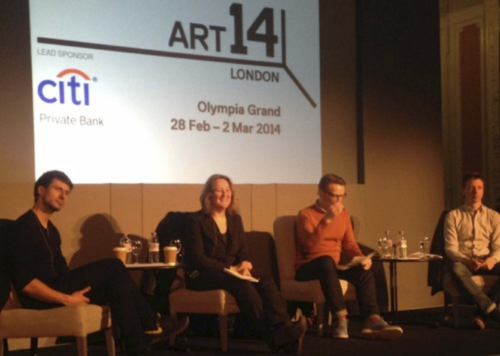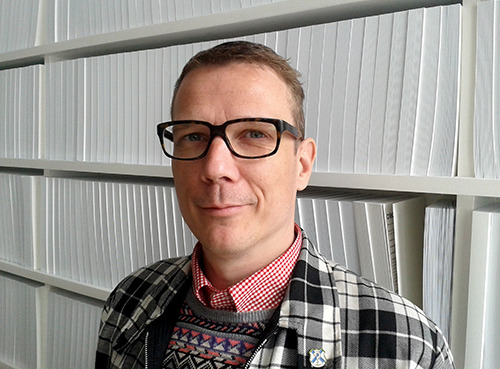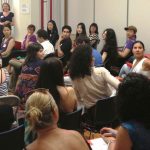Con Edison Immigrant Artist Program Newsletter, Issue No. 56
Interview: Russell Martin of Artquest
This month, NYFA’s Immigrant Artist Program is pleased to introduce Artquest, an online resource and a program of University of the Arts London (UAL), Europe’s largest institute of higher education for the creative arts. Artquest provides “everything a visual artist needs to know” by encouraging critical engagement and providing practical support. Its online services are free and open to artists anywhere.
In March 2014, NYFA and IAP visited Art14, a London-based art fair with an international focus. At the fair, Program Officer (and UAL alumna) Felicity Hogan participated in a panel called “The Truth About Artists,” organized and moderated by Russell Martin, Programme Manager of Artquest. We took the opportunity to learn more about both Artquest and Russell’s artistic practice, and how each influences and interacts with the other.
Can you tell us about the history of Artquest and how it evolved?
Artquest grew out of a survey that London Arts, one of the regional precursors to Arts Council England, undertook in the late 1990s. Interestingly, even back then, the main thing that most artists said that they needed to support their practice was affordable studio space: it came out as the number-one request. Second most needed was a service that allowed any artist, no matter their medium or career stage, to ask any question and get an answer. At its core, that’s what Artquest was founded to do, and it’s still the main part of our service — only now, with the Internet, we can do it in very different ways.
How did you first become involved with Artquest?
As an artist myself, I became involved because I needed a part-time job to support my work. Artquest needed a website to be designed, and our first director understood that the best way Artquest could support artists was by also employing them. All the people at Artquest are artists; everyone works part-time. That means we can connect to artists much more easily — understanding how and why they work, what motivates them, and can more easily find them when we need to know what programs we should deliver.
With its extensive articles, artist-based learning, opportunities, and more, Artquest is a valuable source of information. Do you have a favorite resource, tool, or area of the website you’d like to introduce our artists to that they shouldn’t miss if they visit the website?
There’s so many! We have something over 2,000 pages, built up over the years. If I had to choose, I’d probably pick some of the films. “Museum for Skills” was a one-day conference looking at how hand skills remain important in crafts practice, through presentations by a psychologist, an anthropologist and a consultant surgeon; their take on hand skills is really fascinating, and I think artists have a lot to learn. Also our more recent “An Arts Foundation” series, interviewing people who went to art school — but didn’t become artists — about how their education reflects on their current working lives. It includes a psychotherapist, a gardener, a tech CEO, a mobile designer, and a priest.
Many of NYFA’s staff are practicing artists, as are all the staff at Artquest. Can you tell us about your own artistic practice? How do you manage the balance of your work life and creativity? Does your practice influence your work with Artquest?
When I first took over leading Artquest a couple of years ago — having worked there since 2001 — I was telling an artist at a gallery opening about how I’d have to switch from [working] two days a week to four. They were horrified that I could, as they saw it, quit my practice to become an administrator. I think all artists — all freelancers — are administrators; that administration is as important as some mythical studio experience, and that artistic practice is flexible enough to include almost anything. My artist friend also wondered aloud if Artquest would start to take over my practice: I worried that the reverse would be true!
My work has been based for many years in dialogue and conversation. I arrange events and opportunities for people to meet and talk in specific situations, influenced by Lee Lozano’s “Dialogue Piece” and the writing of David Bohm. So now it feels like many of the projects we work on at Artquest fit with my practice very well. I speak to artists all the time who are organizing exhibitions, setting up galleries and studios, working on international residency programs and applications for everything — that’s all part of their practice, too. Artquest, even though it’s funded and at a huge university, is and always will be an artist-led, artist-centered organization. Working with artists, you remain an artist, almost in spite of yourself.

You are originally from Scotland and studied at The Glasgow School of Art. The city of Glasgow is highly regarded in the international contemporary-art world. When you first moved to London, what struck you most about the differences, if any?
London, weirdly, is definitely more insular. As international as the art world is, artists in London are just as poor as artists anywhere else, so opportunities for travel are often eaten up by rent and bills and food. In Glasgow, there’s an international outlook that runs through everything. When I was there, the sphere of influence was definitely not London; Northern Europe and Scandinavia were much more important — and easier to access. The gatekeepers in London can be pretty picky, and fickle.
London is so huge, with so many artists — guesses range from 6,000-32,000, but no one really knows for sure — that it can just feed on itself, eating up huge numbers of graduates every year and bringing in artists from all over the world. In some ways, artists come to London so London doesn’t have to go to artists!
Saying that, though, it’s an incredibly dynamic melting pot and there’s always something going on, every night of the week: my personal best was fourteen gallery openings in one night. On one street. Artists are also really friendly and helpful: everyone sends recommendations for opportunities to the right people in their circle, and Artquest aims to be a part of that circle for everyone.
London, New York and Berlin are major hubs for contemporary art. Many artists view these cities as the only place to succeed as an artist. In your view, is that a fair statement, or do you see artists in the United Kingdom maintaining sustainable careers outside of London? What challenges (or, conversely, opportunities) do you see artists encounter by living and working in the city?
Opinions differ wildly, but I don’t think you need to be in London, or anywhere else specifically, to be an artist — and it entirely depends on what you mean by success, of course! The UK has clusters of artist communities doing exceptionally well outside of the capital: Cornwall, Leeds, Sheffield, Norwich, Liverpool, Manchester, Newcastle, Nottingham, and so many more have thriving centers of activity, often because artists there decide to work together on festivals, galleries, or with Arts Council England, which does a sterling job in understanding that artists should be everywhere. I think the UK City of Culture project, which started in Glasgow, has had an effect, but much more needs to be done. Our current government seems to think that London is all it needs to worry about, which is shameful.
At Artquest, I’ve advised artists who are trying to get an exhibition to try outside of London first — maybe even outside of the UK. Regions and countries do have different tastes in art, and once you match your work to the right location, things can start to take off.
London, like any city, has huge challenges for any low-paid and undervalued freelance workers, like artists. Rent can be eye-wateringly high, but artists manage to cling on in social housing, living in shared accommodation, or in co-operatives.
What advice do you find yourself offering to immigrant artists looking to establish a creative practice in London? Are there resources available on Artquest that would be applicable to artists working in or around New York City?
The single most important thing for an artist in London, in my opinion, is to cultivate a network. By that, I mean: make friends. Be nice. Share. We’re really all we have to absolutely rely on, and are the best resource for accommodation, studios, materials, tips, skills, and even visits to foreign countries. Artists were doing an informal version of Airbnb and Facebook way before the Internet, and continue to do so today.
The Artquest website aims to be like a giant artist’s brain, with all of the information and advice anyone would need. All the practical stuff, like writing a CV or application, where to apply to for what, how to earn money and make it work for you … through to the more critical decision-making artists have to do — about, for example, how starting a family and maintaining a creative practice can enrich each other, thinking through the kind of work you want to make ,and at what point you’re selling out. We want to share the conversations that artists are already having, and bring these into the light. Our latest project — and first publication — Pamphlets, is based on the idea of 17th-century political pamphlets that were anonymous, faintly scurrilous, and rousing. We asked six artists to talk about the things in the art world that really annoy them — and present solutions. They’ve done a great job, and covered gallery education, the lack of politics in art, lower regional funding, the place of London in the UK art ecosystem ,and much more. The more we talk, the more we can work out what’s going wrong — and how to make it better.




